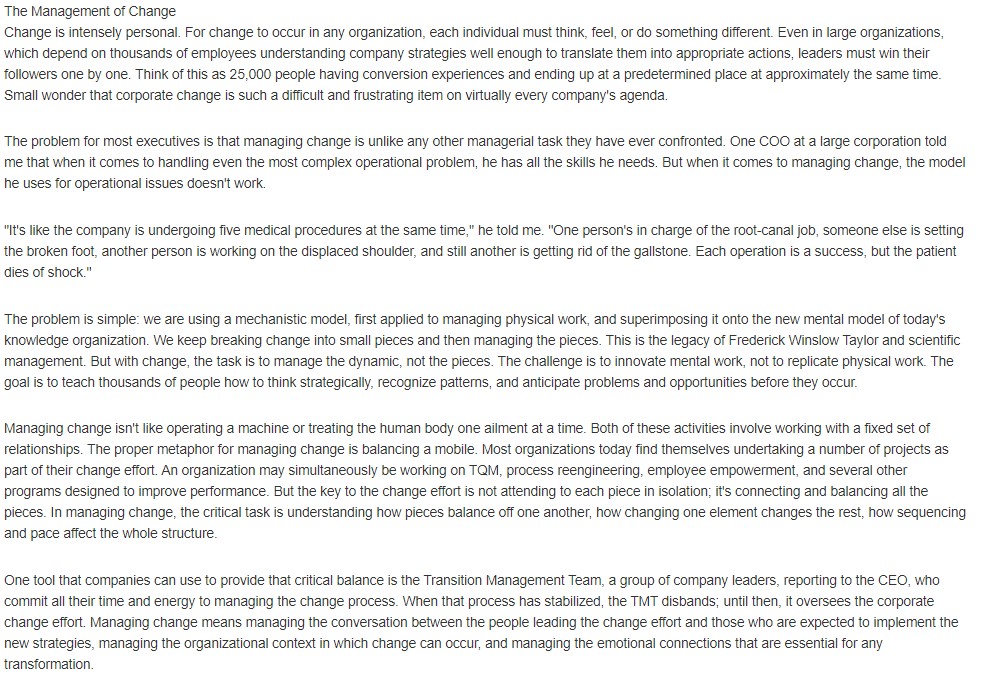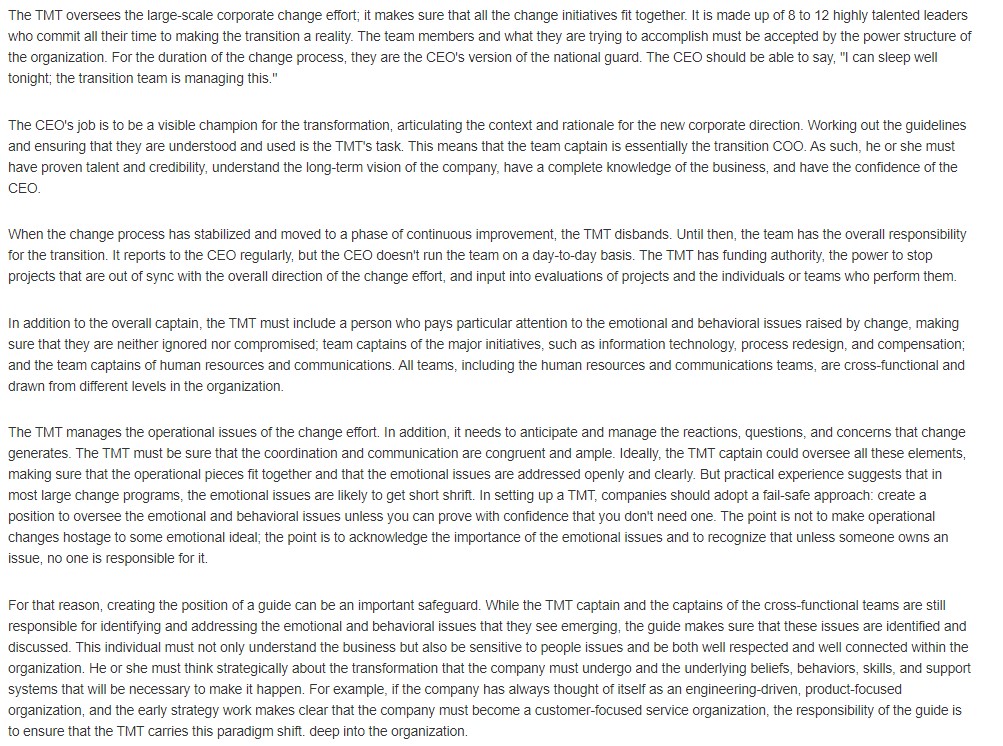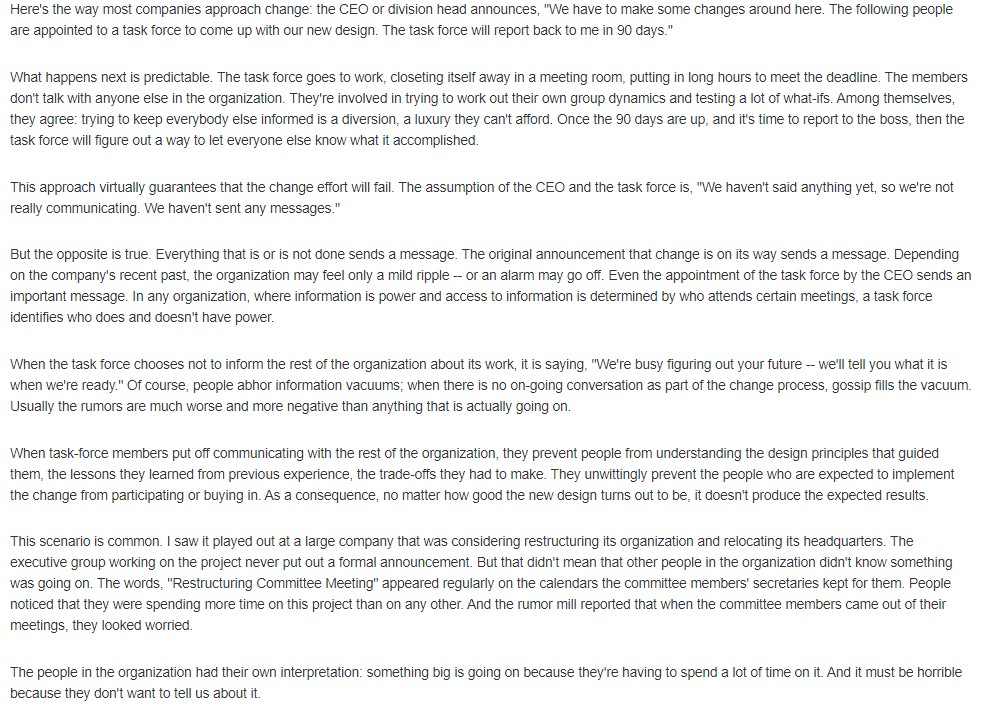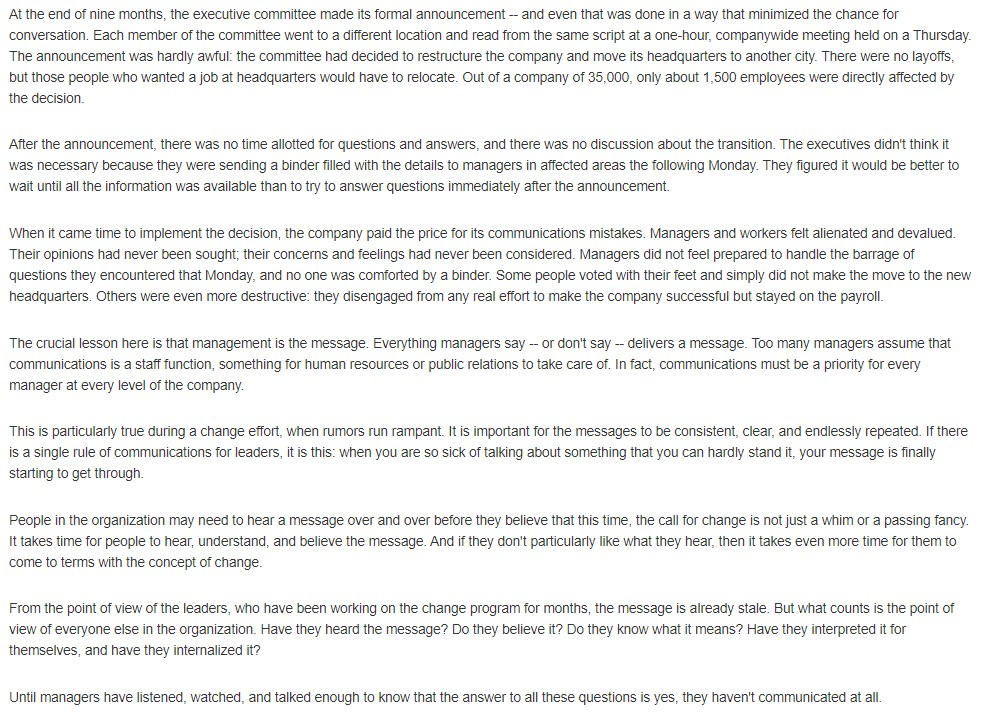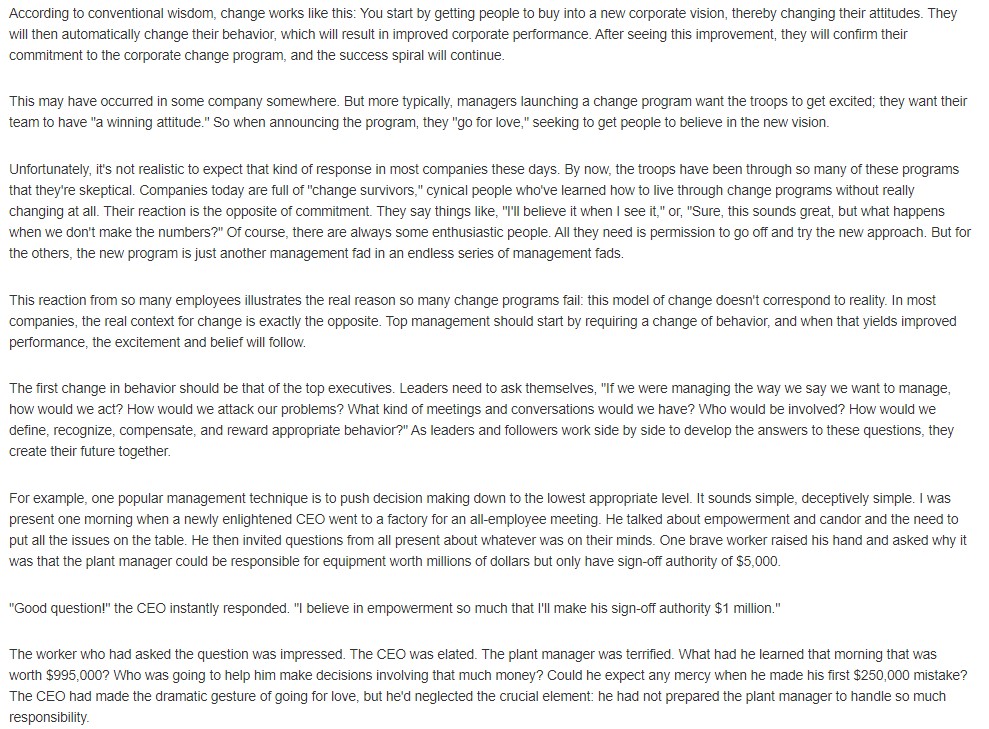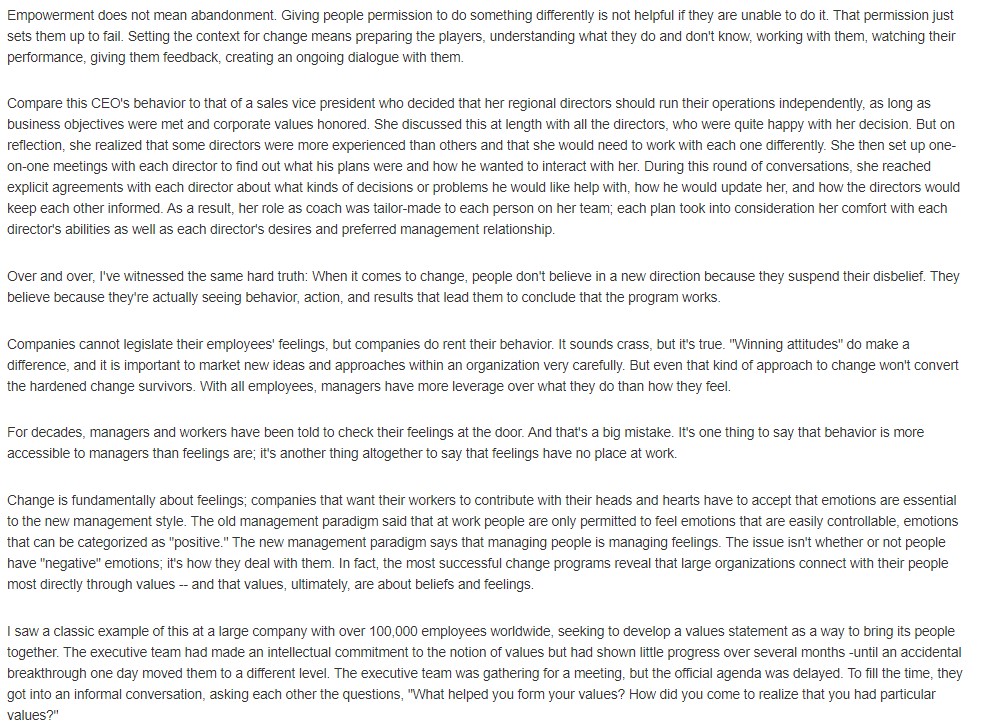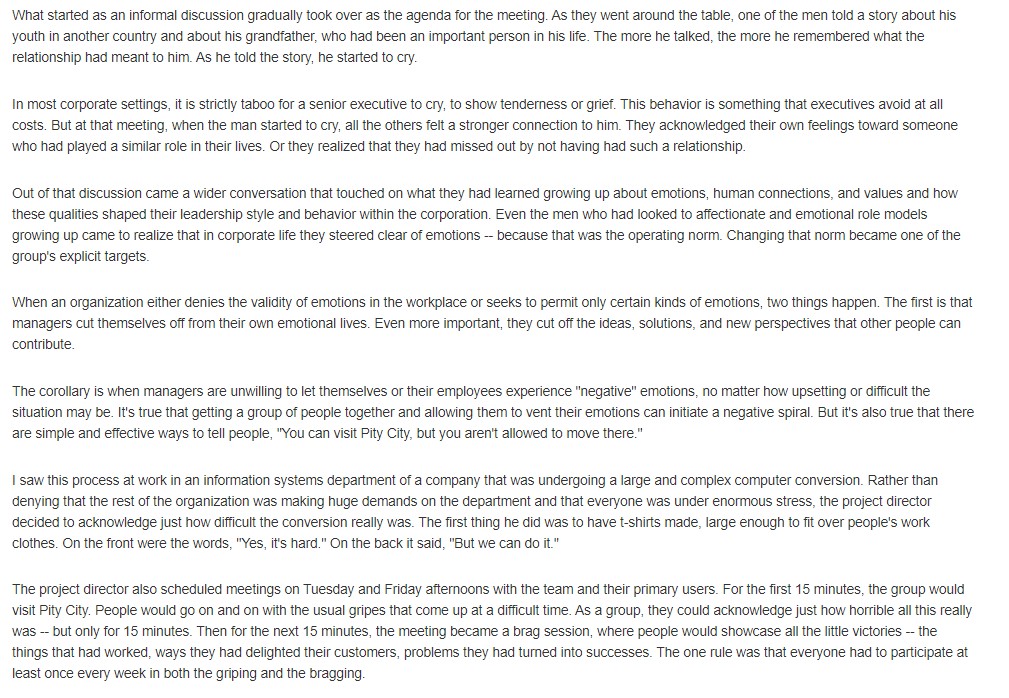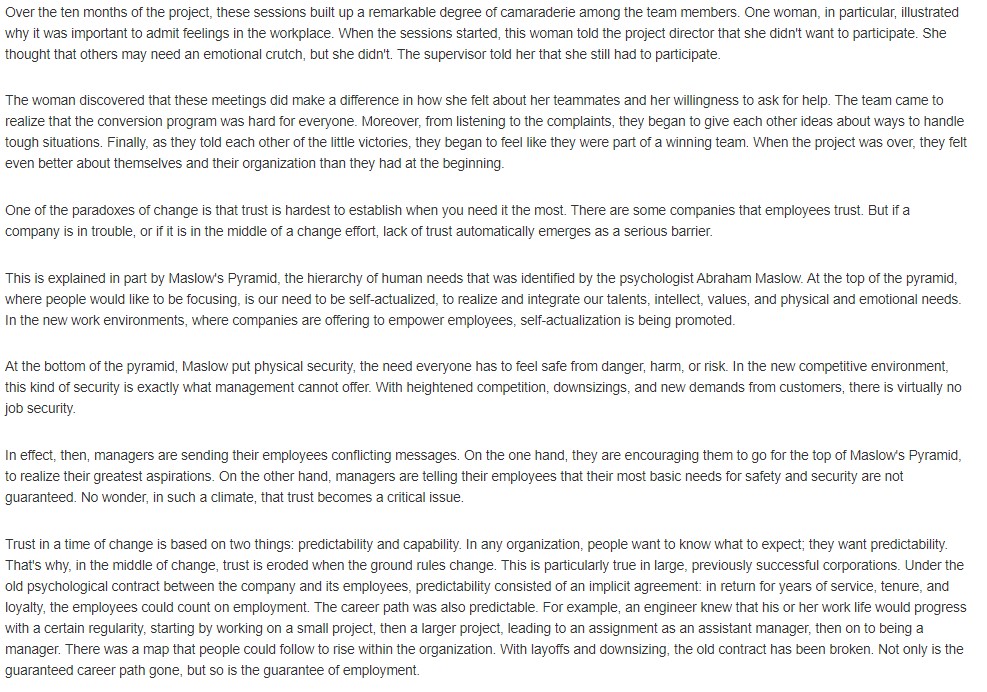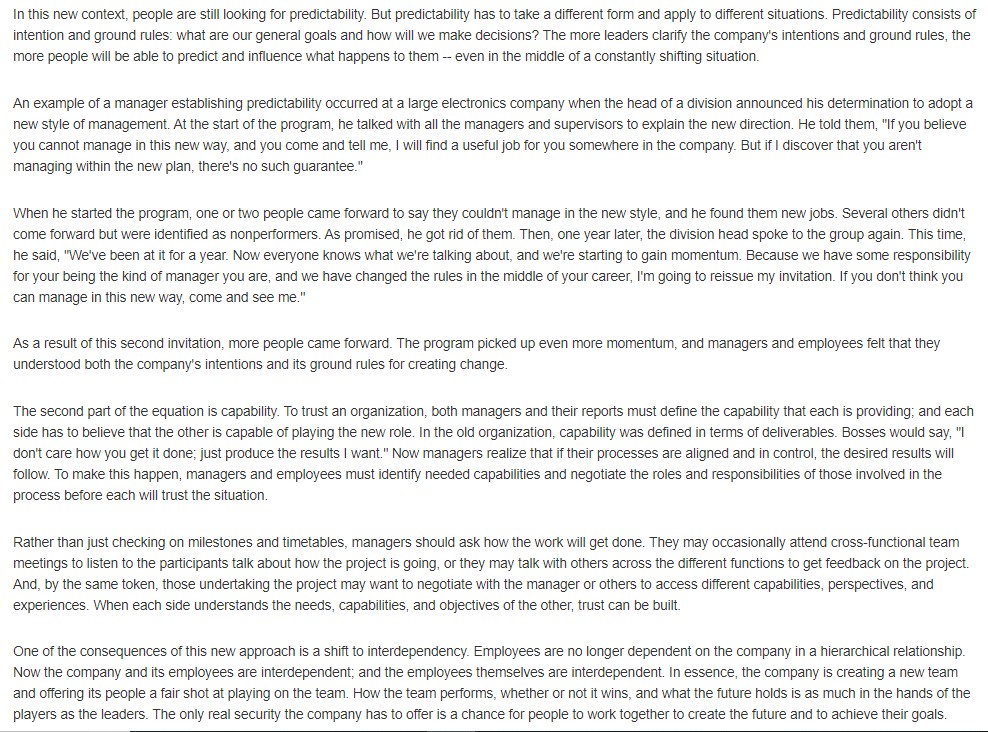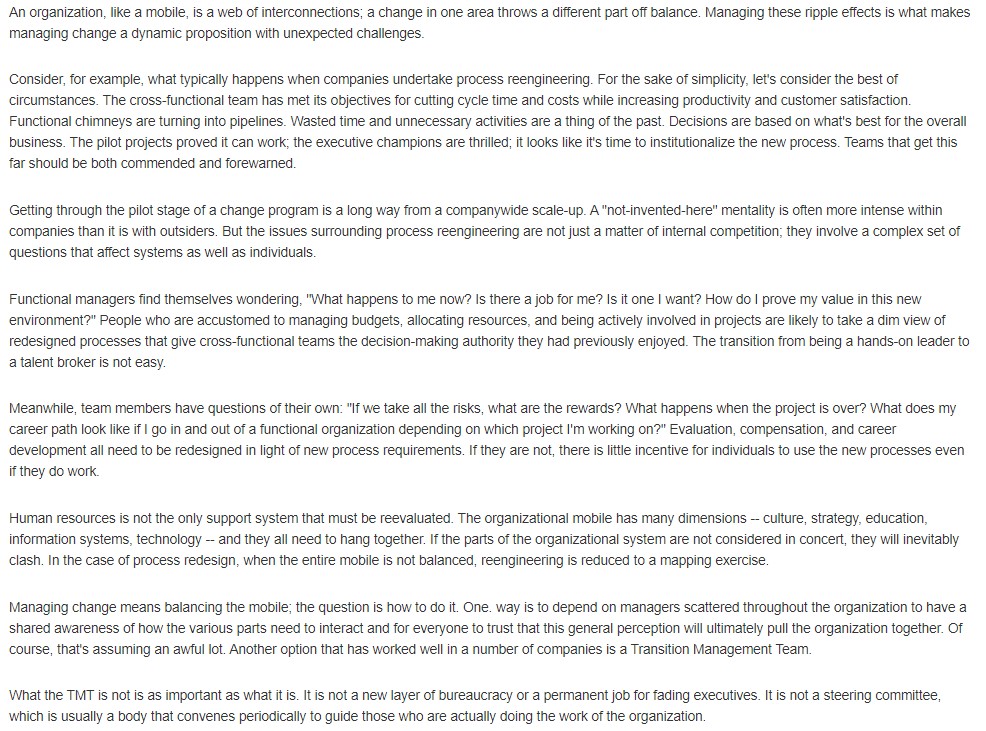Using the article providedManaging Change:The Art of Balancingby Duck, what is the most important aspect of the article?What is the biggest takeaway from the article (and why)?
The Management of Change Change is intensely personal. For change to occur in any organization, each individual must think, feel, or do something different. Even in large organizations, which depend on thousands of employees understanding company strategies well enough to translate them into appropriate actions, leaders must win their followers one by one. Think of this as 25,000 people having conversion experiences and ending up at a predetermined place at approximately the same time. Small wonder that corporate change is such a difficult and frustrating item on virtually every company's agenda. The problem for most executives is that managing change is unlike any other managerial task they have ever confronted. One COO at a large corporation told me that when it comes to handling even the most complex operational problem, he has all the skills he needs. But when it comes to managing change, the model he uses for operational issues doesn't work. "It's like the company is undergoing five medical procedures at the same time," he told me. "One person's in charge of the root-canal job, someone else is setting the broken foot, another person is working on the displaced shoulder, and still another is getting rid of the gallstone. Each operation is a success, but the patient dies of shock." The problem is simple: we are using a mechanistic model, first applied to managing physical work, and superimposing it onto the new mental model of today's knowledge organization. We keep breaking change into small pieces and then managing the pieces. This is the legacy of Frederick Winslow Taylor and scientific management. But with change, the task is to manage the dynamic, not the pieces. The challenge is to innovate mental work, not to replicate physical work. The goal is to teach thousands of people how to think strategically, recognize patterns, and anticipate problems and opportunities before they occur. Managing change isn't like operating a machine or treating the human body one ailment at a time. Both of these activities involve working with a fixed set of relationships. The proper metaphor for managing change is balancing a mobile. Most organizations today find themselves undertaking a number of projects as part of their change effort. An organization may simultaneously be working on TOM, process reengineering, employee empowerment, and several other programs designed to improve performance. But the key to the change effort is not attending to each piece in isolation; it's connecting and balancing all the pieces. In managing change, the critical task is understanding how pieces balance off one another, how changing one element changes the rest, how sequencing and pace affect the whole structure. One tool that companies can use to provide that critical balance is the Transition Management Team, a group of company leaders, reporting to the CEO, who commit all their time and energy to managing the change process. When that process has stabilized, the TMT disbands, until then, it oversees the corporate change effort. Managing change means managing the conversation between the people leading the change effort and those who are expected to implement the new strategies, managing the organizational context in which change can occur, and managing the emotional connections that are essential for any transformation.The TMT oversees the largescale corporate change etTort; it makes sure that all the change initiatives t together. It is made up of 8 to '12 highly talented leaders who commit all their time to making the transition a reality. The team members and what they are trying to accomplish must be accepted bythe power structure of the organization. For the duration ofthe change process, they are the CEO's version of the national guard. The CEO should be able to say, IIIl can sleep well tonight; the transition team is managing this." The CEO's job is to be a visible champion for the transformation, articulating the context and rationale for the new corporate direction. Working out the guidelines and ensuring that they are understood and used is the TMT's task. This means that the team captain is essentially the transition COO. As such, he or she must have proven talent and credibility, understand the longterm vision of the company, have a complete knowledge of the business, and have the condence of the CEO. When the change process has stabilized and moved to a phase of continuous improvement, the TMT disbands. Until then, the team has the overall responsibility for the transition. It reports to the CEO regularly, but the CEO doesn't nm the team on a daytoday basis. The TMT has funding authority, the power to stop projects that are out of sync with the overall direction of the change etTort, and input into evaluations of projects and the individuals or teams who perform them. In addition to the overall captain, the TMT must include a person who pays particular attention to the emotional and behavioral issues raised by change, making sure that they are neither ignored nor compromised; team captains otthe major initiatives, such as information technology, process redesign, and compensation; and the team captains of human resources and communications. All teams, including the human resources and communications teams, are crossfunctional and drawn from ditTerent levels in the organization. The TMT manages the operational issues of the change elTort. In addition, it needs to anticipate and manage the reactions, questions, and concerns that change generates. The TMT must be sure that the coordination and communication are congruent and ample. Ideally, the TMT captain could oversee all these elements, making sure that the operational pieces t together and that the emotional issues are addressed openly and clearly. But practical experience suggests that in most large change programs, the emotional issues are likely to get short sh nit. In setting up a TlvtT, companies should adopt a failsafe approach: create a position to oversee the emotional and behavioral issues unless you can prove with condence that you don't need one. The point is not to make operational changes hostage to some emotional ideal; the point is to acknowledge the importance of the emotional issues and to recognize that unless someone owns an issue, no one is responsible for it. For that reason, creating the position of a guide can be an important safeguard. While the TMT captain and the captains of the crossfunctional teams are still responsible for identifying and addressing the emotional and behavioral issues that they see emerging, the guide makes sure that these issues are identied and discussed. This individual must not only understand the business but also be sensitive to people issues and be both well respected and well connected within the organization. He or she must think strategically about the transformation that the company must undergo and the underlying beliefs, behaviors, skills, and support systemsthat will be necessary to make it happen. For example, ifthe company has always thought of itself as an engineeringdnven, productfocused organization, and the early strategy work makes clear that the company must become a cthtomerfocused service organization, the responsibility of the guide is to ensure that the TlvtT canies this paradigm shift. deep into the organization. The TMT has eight primary responsibilities. This team is not, however, solely accountable for fulfilling these tasks. Establish context for change and provide guidance. The CEO and other executives establish the company's strategic vision. The TMT makes sure that everyone in the organization shares a common understanding of that vision and understands the company's competitive situation. By organizing discussions throughout the organization, the TMT spreads the company's vision and competitive situation so that individuals and teams can accurately align their own activities with the company's new overall direction. Stimulate conversation. Most older, larger companies have formalized their operations in such functional isolation that conversations across levels or functions rarely take place. Instead, people have grown accustomed to presentations followed by inquisitions. Moreover, when resources are scarce and time pressures are severe, conversation often seems a luxury. Yet most change efforts are fundamentally about moving information across old and obsolete boundaries. Consequently, organizing early conversations between different parts of the company and making those conversations an important, sanctioned part of the change process is a critical task for the TMT. Early, open-ended conversations often result in the most productive outcomes; conversely, project leaders who press for early results and close off conversation inside the company usually get to the end of a project with little to show in the way of new insight or real breakthrough thinking. Provide appropriate resources. The TMT has two types of significant power. the power to allocate resources to make things happen and the power to kill projects that are no longer needed. In the first category, the TMT does command time and budgets. Frequently, change efforts falter because the people who are drafted to play important roles in leading teams work only on the margins. As a result, the team never has a real process owner or receives adequate attention. The TMT can change that; it can designate individuals who take on the authority and are given the time and resources to do the job properly. The TMT can also kill off old projects that no longer have a high priority. In many organizations, the operating maxim is, "Old projects never die, they just get underfunded." Nobody is willing to make the tough decision to cut a project that has outlived its usefulness. The result is a lot of projects that are more dead than alive but still distracting people and using resources. The TMT needs to be the tough-minded terminator of these projects. Coordinate and align projects. As company's shift into fast-paced change programs, task forces, teams, and projects proliferate. One result is a great deal of enthusiasm, energy, and activity. Another is confusion. Even if every activity is valid and necessary, the problem is that they don't seem to fit together. The TMT has two tasks: coordinating and aligning the projects into building blocks that fit together; and communicating to the whole organization how the pieces align so that others can see the larger picture and appreciate that there is a coherent plan. Ensure congruence of messages, activities, policies, and behaviors. One of the major complaints of people in organizations undergoing a transition is that management doesn't "walk the talk." They say "empowerment" -- and then shoot down every new idea that comes from their employees. The TMT's job is to be on the lookout for inconsistencies that undermine the credibility of the change effort. The message, the measures, the behaviors, and the rewards must match.Provide opportunities for joint creation. Most change programs today embrace the concept of empowerment but never get around to defining it. In some companies, empowerment essentially is, "Do what I say and act as if you like it." In others, it is interpreted to mean, "Everybody gets to vote on everything." My working definition of empowerment is a true opportunity for employees throughout the company to create the future together. That means ensuring that all employees, whether managers, directors, factory workers, or technical staff, have the information they need to make correct decisions and take appropriate actions. Clearly, the TMT cannot do all the communicating and teaching; it is the designer, coordinator, and support source for that learning and creation. Anticipate, identify, and address people problems. There is a reason why the guide and the communications and human resources teams are all represented on the TMT: people issues are at the heart of change. For example, a change that involves delayering, changing job descriptions, or compensation also requires advance notification and long lead time. Communications and human resources are critical to success, yet there are routine shortages of talent, diversity of perspective, dollars, and share of mind. Cross-functional teams in communications and human resources represent an opportunity for gathering and distributing information, both horizontally and vertically, throughout the organization. Prepare the critical mass. Given the complexity of scale-up from creating the pilot to making it the norm, it is important to design into the work from the very beginning the resources and strategy necessary for replication and learning transfer. Most teams will need guidance on how to do this as well as help to make sure that what they are doing fits with other activities. The organizing element of all these activities is the hard work of educating, training, and preparing the organization to think, feel, and act differently. In companies where change is successful, the leaders look at the whole mobile and the congruence of operations and emotions. It is far too easy to equate change with specific tasks. When the TMT manages both the content and the process, the operations and the emotions, it provides a powerful lever for change. The real contribution of leadership in a time of change lies in managing the dynamics, not the pieces. The fundamental job of leadership is to deal with the dynamics of change, the confluence and congruence of the forces that change unleashes, so that the company is better prepared to compete.Here's the way most companies approach change: the CEO or division head announces, 'We have to make some changes around here. The following people are appointed to a task force to come up with our new design. The task force will report back to me in 90 days." What happens next is predictable. The task force goes to work, closeting itserf away in a meeting room, putting in long hours to meet the deadline. The members don"t talk with anyone else in the organization. They're involved in trying to work out their own group dynamics and testing a lot of whatifs. Among themselves, they agree: trying to keep everybody else informed is a diversion, a luxury they can't aord. Once the 90 days are up, and it's time to report to the boss, then the task force will gure out a way to let everyone else know what it accomplished. This approach virtually guarantees that the change etfort will fail. The assumption of the CEO and the task force is, "'W'e haven't said anything yet, so we're not really communicating. We haven't sent any messages." But the opposite is true. Everything that is or is not done sends a message. The original announcement that change is on its way sends a message. Depending on the company's recent past, the organizaon may feel only a mild ripple or an alarm may go off. Even the appointment of the task force by the CED sends an important message. In any organization, where information is power and access to information is determined bywho attends certain meetings, a task force identies who does and doesn't have power. When the task force chooses not to inform the rest of the organization about its work, it is saying, 'We' re busy guring out your future we'll tell you what it is when we're ready." Of course, people abhor information vacuums; when there is no ongoing conversation as part of the change process, gossip lls the vacuum. Usually the rumrs are much worse and more negative titan anything that is actually going on. When taskforce members put off communicating with the rest of the organization, they prevent people from understanding the design principles that guided them, the lessons they teamed from previous experience, the tradeos they had to make. They unwittingly prevent the people who are expected to implement the change from participating or buying in. As a consequence, no matter how good the new design tums out to be, it doesn't produce the expected results. This scenario is common. I saw it played out at a large company that was considering resti'uctunng its organization and relocating its headquarters. The executive group working on the project never put out a formal announcement. But that didn't mean that other people in the organization didn't know something was going on. The words, "Restructuring Committee Meeting" appeared regularly on the calendars the committee members' secretaries kept forthem. People noticed that they were spending more time on this project than on any other. And the rumor mill reported that when the committee members came out of their meetings, they looked worried. The people in the organization had theircwn interpretation: something big is going on because they're having to spend a lot of time on it. And it must be honible because they don't want to tell us about it. At the end of nine months, the executive committee made its fomial announcement and even that was done in a way that minimized the chance for conversation. Each member of the committee went to a dilTerent location and read from the same script at a one-hour, companywide meeting held on a Thursday. The announcement was hardly awful: the committee had decided to resthcture the company and move its headquarters to another city. There were no Iayoth, but those people who wanted a job at headquarters would have to relocate. Out cfa company of 35,000, only about 1,500 employees were directly affected by the decision. After the announcement, there was no time allotted for questions and answers, and there was no discussion about the transition. The executives didn't think it was necessary because they were sending a binder lled with the details to managers in affected areas the following Monday. They gured it would be better to wait until all the information was available than to try to answer questions immediately alter the announcement. When it came time to implement the decision, the company paid the price for its communications mistakes. Managers and workers felt alienated and devalued. Their opinions had never been sought; their concerns and feelings had never been considered. Managers did not feel prepared to handle the banage of questions they encountered that Monday, and no one was comforted by a binder. Some people voted with their feet and simply did not make the move to the new headquarters. Others were even more destructive: they disengaged from any real effort to make the company successful but stayed on the payroll. The crucial lesson here is that management is the message. Everything managers say or don't say delivers a message. Too many managers assume that communications is a staff function, something for human resources or public relations to take care of. In fact, communications must be a pncnty for every manager at every level of the company. This is particulany true during a change effort, Mien rumors run rampant. It is important Torthe messages to be consistent, clear, and endlessly repeated. Ifthere is a single rule of communications for leaders, it is this: when you are so sick of talking about something that you can hardly stand it, your message is nally starting to get through. People in the organization may need to near a message over and over before they believe that this time, the call for change is not just a whim or a passing fancy. It takes time for people to hear, understand, and believe the message. And if they don't particulany like what they hear, then it takes even more time for them to come to tenns with the concept of change. From the point of view of the leaders, who have been working on the change program for months, the message is already stale. But what counts is the point of view of everyone else in the organization. Have they heard the message? Do they believe it? Do they know what it means? Have they interpreted it for themselves, and have they intemalized it? Until managers have listened, watched, and talked enough to know that the answer to all these questions is yes, they haven't communicated at all. According to conventional wisdom, change works like this: You start by getting people to buy into a new corporate vision, thereby changing their attitudes. They will then automatically change their behavior, which will result in improved corporate performance. After seeing this improvement, they will confirm their commitment to the corporate change program, and the success spiral will continue. This may have occurred in some company somewhere. But more typically, managers launching a change program want the troops to get excited; they want their team to have "a winning attitude." So when announcing the program, they "go for love," seeking to get people to believe in the new vision. Unfortunately, it's not realistic to expect that kind of response in most companies these days. By now, the troops have been through so many of these programs that they're skeptical. Companies today are full of "change survivors," cynical people who've learned how to live through change programs without really changing at all. Their reaction is the opposite of commitment. They say things like, "I'll believe it when I see it," or, "Sure, this sounds great, but what happens when we don't make the numbers?" Of course, there are always some enthusiastic people. All they need is permission to go off and try the new approach. But for the others, the new program is just another management fad in an endless series of management fads. This reaction from so many employees illustrates the real reason so many change programs fail: this model of change doesn't correspond to reality. In most companies, the real context for change is exactly the opposite. Top management should start by requiring a change of behavior, and when that yields improved performance, the excitement and belief will follow. The first change in behavior should be that of the top executives. Leaders need to ask themselves, "If we were managing the way we say we want to manage, how would we act? How would we attack our problems? What kind of meetings and conversations would we have? Who would be involved? How would we define, recognize, compensate, and reward appropriate behavior?" As leaders and followers work side by side to develop the answers to these questions, they create their future together. For example, one popular management technique is to push decision making down to the lowest appropriate level. It sounds simple, deceptively simple. I was present one morning when a newly enlightened CEO went to a factory for an all-employee meeting. He talked about empowerment and candor and the need to put all the issues on the table. He then invited questions from all present about whatever was on their minds. One brave worker raised his hand and asked why it was that the plant manager could be responsible for equipment worth millions of dollars but only have sign-off authority of $5,000. "Good question!" the CEO instantly responded. "I believe in empowerment so much that I'll make his sign-off authority $1 million." The worker who had asked the question was impressed. The CEO was elated. The plant manager was terrified. What had he learned that morning that was worth $995,000? Who was going to help him make decisions involving that much money? Could he expect any mercy when he made his first $250,000 mistake? The CEO had made the dramatic gesture of going for love, but he'd neglected the crucial element: he had not prepared the plant manager to handle so much responsibility.Empowerment does not mean abandonment. Giving people permission to do something differently is not helpful if they are unable to do it. That permission just sets them up to fail. Setting the context for change means preparing the players, understanding what they do and don't know, working with them, watching their performance, giving them feedback, creating an ongoing dialogue with them. Compare this CEO's behavior to that of a sales vice president who decided that her regional directors should run their operations independently, as long as business objectives were met and corporate values honored. She discussed this at length with all the directors, wfro were quite happy with her decision. But on reection, she realized that some directors were more experienced than others and that she would need to work with each one d'rlTerently. She then set up one- onone meetings with each director to nd out what his plans were and how he wanted to interact with her. During this round ofconversations, she reached explicit agreen'ents with each director about what kinds of decisions or problems he would like help with, how he would update her, and how the directors would keep each other informed. As a result, her role as coach wastailormade to each person on her team; each plan took into consideration her corrrfcrt with each director's abilities as well as each director's desires and preferred management relationship. Over and over, I've witnessed the same hard tnrth: When it comes to change, people don't believe in a new direction because they suspend their disbelief. They believe because they're actually seeing behavior, action, and results that lead them to conclude that the program works. Companies cannot legislate their employees' feelings, but companies do rent their behavior. It sounds crass, but it's true. "Winning attitudes" do make a difference, and it is important to market new ideas and approaches within an organization very carefully. But even that kind of approach to change won't convert the hardened change survivors. With all employees, managers have more leverage over wfrat they do than how they feel. For decades, managers and workers have been told to check their feelings at the door. And that's a big mistake. It's one thing to say that behavior is more accessible to managers than feelings are; it's another thing altogetherto say that feelings have no place at work. Change is fundamentally about feelings; companies that want their workers to contribute with their heads and hearts have to accept that emotions are essential to the new management style. The old management paradigm said that at work people are only pennltted to feel emotions that are easily controllable, emotions that can be categorized as "positive." The new management paradigm says that managing people is managing feelings. The issue isn't whether or not people have "negative" emotions; it's how they deal with them. In fact, the most successful change programs reveal that large organizations connect with their people most directly through values and that values, ultimately, are about beliefs and feelings. I saw a classic example of this at a large company with over 100,000 employees worldwide, seeking to develop a values statement as a way to bring its people together. The executive team had made an intellectual commitment to the notion of values but had shown little progress over several months -u ntil an accidental breakthrough one day moved them to a different level. The executive team was gathering for a meeting, but the ofcial agenda was delayed. To ll the time, they got into an lnfcrrnal conversation, asking each otherthe questions, 'mmat helped you form your values? How did you come to realize that you had particular values?" What started as an informal discussion gradually took over as the agenda for the meeting. As they went around the table, one of the men told a story about his youth in another country and about his grandfather, who had been an important person in his life. The more he talked, the more he remembered what the relationship had meant to him. As he told the story, he started to cry. In most corporate settings, it is strictly taboo for a senior executive to cry, to show tenderness or grief. This behavior is something that executives avoid at all costs. But at that meeting, when the man started to cry, all the others felt a stronger connection to him. They acknowledged their own feelings toward someone who had played a similar role in their lives. Or they realized that they had missed out by not having had such a relationship. Out of that discussion came a wider conversation that touched on what they had learned growing up about emotions, human connections, and values and how these qualities shaped their leadership style and behavior within the corporation. Even the men who had looked to affectionate and emotional role models growing up came to realize that in corporate life they steered clear of emotions -- because that was the operating norm. Changing that norm became one of the group's explicit targets. When an organization either denies the validity of emotions in the workplace or seeks to permit only certain kinds of emotions, two things happen. The first is that managers cut themselves off from their own emotional lives. Even more important, they cut off the ideas, solutions, and new perspectives that other people can contribute. The corollary is when managers are unwilling to let themselves or their employees experience "negative" emotions, no matter how upsetting or difficult the situation may be. It's true that getting a group of people together and allowing them to vent their emotions can initiate a negative spiral. But it's also true that there are simple and effective ways to tell people, "You can visit Pity City, but you aren't allowed to move there." I saw this process at work in an information systems department of a company that was undergoing a large and complex computer conversion. Rather than denying that the rest of the organization was making huge demands on the department and that everyone was under enormous stress, the project director decided to acknowledge just how difficult the conversion really was. The first thing he did was to have t-shirts made, large enough to fit over people's work clothes. On the front were the words, "Yes, it's hard." On the back it said, "But we can do it." The project director also scheduled meetings on Tuesday and Friday afternoons with the team and their primary users. For the first 15 minutes, the group would visit Pity City. People would go on and on with the usual gripes that come up at a difficult time. As a group, they could acknowledge just how horrible all this really was -- but only for 15 minutes. Then for the next 15 minutes, the meeting became a brag session, where people would showcase all the little victories -- the things that had worked, ways they had delighted their customers, problems they had turned into successes. The one rule was that everyone had to participate at least once every week in both the griping and the bragging.Overthe ten months of the project, these sessions built up a remarkable degree of camaraderie among the team members. One woman, in particular, illustrated why it was important to admit feelings in the workplace. When the sessions started, this woman told the project director that she didn't want to participate. She thought that others may need an emotional crutch, but she didn't. The supervisor told her that she still had to participate. The woman discovered that these meetings did make a dierence in how she felt about her teammates and her willingness to ask for help. The team came to realize that the conversion program was hard for everyone. Moreover, from listening to the complaints, they began to give each other ideas about ways to handle tough situations. Finally, as they told each other of the little victories, they began to feel like they were part of a winning team. When the project was over, they felt even better about themselves and their organization than they had at the beginning. One of the paradoxes of change is that trust is hardest to establish when you need it the most. There are some companies that employees trust. But if a company is in trouble, or if it is in the middle of a change elTort, lack of dust automatically emerges as a serious banier. This is explained in part by Maslow's Pyramid, the hierarchy of human needs that was identied by the psychologistAbraham Maslow. At the top of the pyramid, where people would like to be focusing, is our need to be selfactualized, to realize and integrate our talents, intellect, values, and physical and emotional needs. In the new work environments, where companies are otiering to empower employees, selfactualization is being promoted. At the bottom ofthe pyramid, Maslow put physical security, the need everyone has to feel safe from danger, harm, or risk. In the new competitive environment, this kind of security is exactly what management cannot olTer. With heightened competition, downsizings, and new demands from customers, there is virtually no job security. In elTect, then, managers are sending their employees conicting messages. On the one hand, they are encouraging them to go for the top of MasloWs Pyramid, to realize their greatest aspirations. On the other hand, managers are telling their employees that their most basic needs for safety and security are not guaranteed. No wonder, in such a climate, that thst becomes a critical issue. Trust in a time of change is based on two things: predictability and capability. In any organization, people want to know what to expect; they want predictability. That's why, in the middle of change, trust is eroded when the ground rules change. This is particularly line in large, previously successful corporations. Under the old psychological contract between the company and its employees, predictability consisted of an implicit agreement: in return for years of service, tenure, and loyalty, the employees could count on employment. The career path was also predictable. For example, an engineer knew that his or her work life would progress with a certain regularity, starting by working on a small project, then a larger project, leading to an assignment as an assistant manager, then on to being a manager. There was a map that people could fol lowr to rise within the organization. With laonTs and downsizing, the old contract has been broken. Not only is the guaranteed career path gone, but so is the guarantee of employment. In this new context, people are still looking for predictability. But predictability has to take a different form and apply to different situations. Predictability consists of intention and ground rules: what are our general goals and how will we make decisions? The more leaders clarify the company's intentions and ground rules, the more people will be able to predict and influence what happens to them -- even in the middle of a constantly shifting situation. An example of a manager establishing predictability occurred at a large electronics company when the head of a division announced his determination to adopt a new style of management. At the start of the program, he talked with all the managers and supervisors to explain the new direction. He told them, "If you believe you cannot manage in this new way, and you come and tell me, I will find a useful job for you somewhere in the company. But if I discover that you aren't managing within the new plan, there's no such guarantee." When he started the program, one or two people came forward to say they couldn't manage in the new style, and he found them new jobs. Several others didn't come forward but were identified as nonperformers. As promised, he got rid of them. Then, one year later, the division head spoke to the group again. This time, he said, "We've been at it for a year. Now everyone knows what we're talking about, and we're starting to gain momentum. Because we have some responsibility for your being the kind of manager you are, and we have changed the rules in the middle of your career, I'm going to reissue my invitation. If you don't think you can manage in this new way, come and see me." As a result of this second invitation, more people came forward. The program picked up even more momentum, and managers and employees felt that they understood both the company's intentions and its ground rules for creating change. The second part of the equation is capability. To trust an organization, both managers and their reports must define the capability that each is providing; and each side has to believe that the other is capable of playing the new role. In the old organization, capability was defined in terms of deliverables. Bosses would say, "I don't care how you get it done; just produce the results I want." Now managers realize that if their processes are aligned and in control, the desired results will follow. To make this happen, managers and employees must identify needed capabilities and negotiate the roles and responsibilities of those involved in the process before each will trust the situation. Rather than just checking on milestones and timetables, managers should ask how the work will get done. They may occasionally attend cross-functional team meetings to listen to the participants talk about how the project is going, or they may talk with others across the different functions to get feedback on the project. And, by the same token, those undertaking the project may want to negotiate with the manager or others to access different capabilities, perspectives, and experiences. When each side understands the needs, capabilities, and objectives of the other, trust can be built. One of the consequences of this new approach is a shift to interdependency. Employees are no longer dependent on the company in a hierarchical relationship. Now the company and its employees are interdependent; and the employees themselves are interdependent. In essence, the company is creating a new team and offering its people a fair shot at playing on the team. How the team performs, whether or not it wins, and what the future holds is as much in the hands of the players as the leaders. The only real security the company has to offer is a chance for people to work together to create the future and to achieve their goals.An organization, like a mobile, is a web of interconnections; a change in one area throws a dierent part oiT balance. Managing these ripple etTects is what makes managing change a dynamic proposition with unexpected challenges. Consider. for example, what typically happens when companies undertake process reengineenhg. Forthe sake of simplicity, let's consider the best of circumstances. The crosstunctional team has met its objectives for cutting cycle time and costs while increasing productivity and customer satisfaction. Functional chimneys are turning into pipelines. Wasted time and unnecessary activities are a thing of the past. Decisions are based on what's best forthe overall business. The pilot projects proved it can work; the executive champions are thrilled; it looks like it's time to institutionalize the new process. Teams that get this far should be both commended and iorewamed. Getting through the pilot stage of a change program is a long way from a companywide scaleup. A "notinventedhere" mentality is often more intense vrithin companies than it is with outsiders. But the issues suncunding process reengineering are not just a matter of internal competition; they involve a complex set of questions that attect systems as well as individuals. Functional managers nd themselves wondering, 'What happens to me now? Is there a job for rre? Is it one I want? How do I prove my value in this new environment?" People who are accustomed to managing budgets, allocating resources, and being actively involved in projects are likely to take a dim view of redesigned processes that give crosstunctional teams the decisionmaking authority they had previously enjoyed. The transition from being a handscn leader to a talent broker is not easy. Meanwhile, team members have questions of their own: "If we take all the risks. what are the rewards? What happens when the project is over? What does my career path look like ifl go in and out of a tiJnctional organization depending on which project I'm \"toning on?" Evaluation. compensation, and career development all need to be redesigned in light of new process requirements. If they are not, there is little incentive for individuals to use the new processes even rr they do work. Human resources is hot the only support system that must be reevaluated. The organizational mobile has many dimensions culture, strategy, education, information systems, technology and they all need to hang together. If the parts of the organizational system are not considered in concert, they will inevitably clash. In the case of process redesign, witen the entire mobile is not balanced, reengineering is reduced to a mapping exercise. Managing change means balancing the mobile; the question is how to do it. One. way is to depend on managers scattered throughout the organization to have a shared awareness of how the various parts need to interact and for everyone to thst that this general perception will ultimately pull the organization together. Of course, that's assuming an awful lot. Another option that has worked well in a number of companies is a Transition Management Team. What the TMT is not is as important as witat it is. It is not a new layer of bureaucracy or a pennaneht job for fading executives. It is not a steering committee, which is usually a body that convenes periodically to guide those who are actually doing the work of the organization
